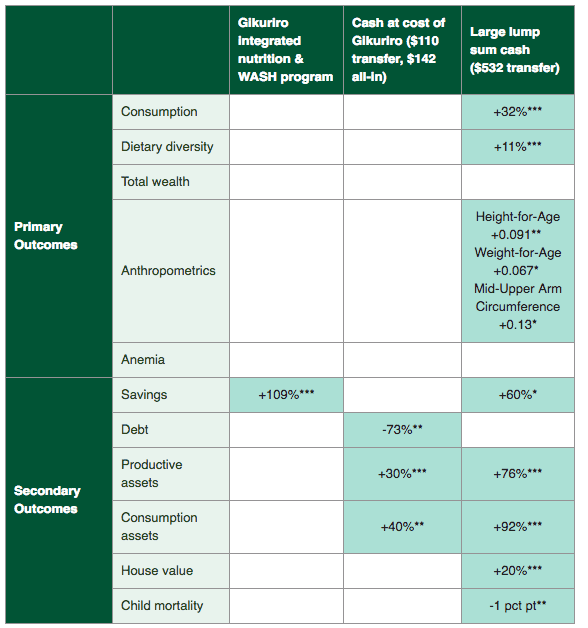Today we can finally share with you something we’ve been hard at work on for over 4 years: the results from our first experimental benchmarking study, a unique collaboration with USAID, Google.org, and academic and implementing partners set in Rwanda.
The animating idea behind this project is incredibly simple: if we’re serious about helping other people, we should check whether we’re doing more good for them than they could for themselves with the money. That idea seems hard to argue with, and it’s been a core part of our worldview from day one.
But making it happen in practice has been anything but simple. The story of this particular collaboration is long and full of twists, starting all the way back in 2013 when we were just starting to work in Kenya. At that point NPR ran a widely-discussed piece about what we were up to. And at one point in that piece they contrasted cash transfers with giving out livestock and asked if it would be interesting to compare or “benchmark” the effects. We said, why not?
As it turns out, one of the people who heard that piece was the Mission Economist in USAID’s Rwandan office, Daniel Handel. Daniel thought the idea of benchmarking made sense, and wanted to try it. That triggered a series of conversations with USAID staff in Washington, DC and our friends at Google.org. Those led to the creation of a “Global Development Alliance,” a novel partnership structure that lets USAID leverage private-sector capital and expertise to do creative things – like, in this case, run A/B tests of different policy options. Then we had to work with the general counsel’s office to articulate principles under which cash transfers were an acceptable use of taxpayer funds. Then we worked with the USAID team in Rwanda to figure out which of their activities would be most valuable to compare with cash transfers. Then we worked with the lead researchers, Craig McIntosh and Andy Zeitlin, and another implementing organization to design and run one of the more complex randomized controlled trials we’ve been involved in. So, it’s been a journey.
After all of that, the results. Cash transfers had effects in line with existing research, and in particular larger transfers had significant effects on three of the five primary outcomes that USAID was hoping to shift. A holistic WASH and nutrition intervention increased savings but did not affect any of the primary outcomes, which is disappointing though obviously useful to know. A similarly sized cash transfer also did not affect the primary outcomes, but drove a significant increase in assets and reduction in debt. We’ve put together a short summary of these patterns below.

Significance: * = 10%, ** = 5%, *** = 1%
For anthropometrics, showing change in Z scores.
Several secondary outcomes not affected by any intervention (e.g., sanitation practice).
—
This study is made possible by the generous support of Good Ventures, and the American people through USAID. The contents of this blog are the responsibility of GiveDirectly, and do not necessarily reflect the views of USAID or the United States Government.
